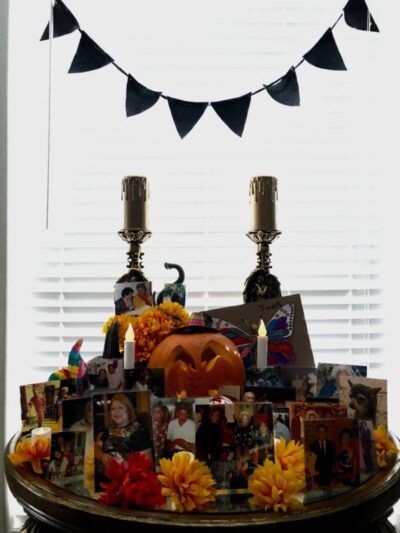My mother, Patricia Gil Faz. I called her ama, we had our moments. We butted heads and we both knew what to say to get under each others skin. My Spanish is not the best and I knew a lot got lost when we spoke. But she would throw some hard words at me “ eres una piedra en mi zapato Chula”. Then we would have great moments, she taught us to be loving and treat people with respect. To take care and trust family because that’s what we have. She was raised by two strong women and she passed that strength to her children and grandchildren. She had an amazing laugh that was contagious and she brought out the best in people. I always saw her helping others no matter if they can repay the favor back or not. Everyone was her favorite and she would tell you if you were. I wish my daughter and son could have met her and knew how much love she had for them. I love her so much and miss those moments when she would reach over and hold my hand. Now I have these beautiful memories that I get to pass on to my children.
Month: October 2018
Video Ofrenda by El Centro College’s Mexican-American Studies Class
Students from Mexican-American Studies (HUMA 1305) are a rowdy and talented bunch of young people (and not so young!) who come together every week to discuss the history and culture of Mexicans and Mexican-Americans. We honor this culture as being native to this country, not immigrant. We acknowledge the legacy of colonization, racism and oppression while uplifting the stories of struggle, resistance, organizing, creativity and love from within the community. We listen to music, read plays and discuss the important role of cross-cultural exchange in our modern context. We thank the culture bearers in Dallas for inviting us to share our story! Professor Vanessa Mercado-Taylor is an Indigena Mexicana/Colombiana artist and educator who every day gets the amazing privilege of speaking to students about art and culture while helping them find their voice and power in their communities.
Celebrando Day of the Dead by Isabel Montemayor
My father always says, “Don’t be afraid of the dead, have fear of the living,” this saying gives perfect entrée to a brief discussion of Day of the Dead. Dia de los Muertos is more than just a holiday celebrated throughout Latin America, with great prominence in central and southern Mexico. Those who maintain the traditions of Dia de los Muertos embody a particular worldview often over looked by the fetishization of this holiday through mainstream commercialization in recent years. Closer examination of this worldview sheds light on some of the beliefs and traditions associated with this holiday.
The festivities of day of the dead have a long history in regions with pre-hispanic indigenous ties. Prior to European colonization Aztec celebrations that honored the goddess of the afterlife, Mictecacihuatl were prominent in central Mexico. When Europeans arrived in the 15th century, these indigenous celebrations were combined with the Judeo-Christian beliefs of All Souls Eve, All Souls Day and All Saints Day, all of which continue to be celebrated according to the Catholic Triduum. Dia de los Muertos thus serves as an example of what anthropologists call religious syncretism or a combining of religious beliefs to suit the needs of a changing or diverse population.
An essential part of Dia de los Muertos is the reunion of the extended family unit at the cemeteries where family members are buried, as well as in the homes of the deceased. Neither place invokes fear, rather these places serve as conduits for allowing the souls of the deceased to be reunited temporarily for festivities with the living. Special prayers, rosaries, and masses are offered during this time to honor those who have passed away.
While many may think that Dia de los Muertos idolizes death because of the candy skulls and altars/ofrendas, these three days actually honor the lives of the deceased. Life is essentially believed to be interconnected with death as a continuous cycle that is embraced rather than feared. Ofrendas (offerings) are prepared in the home of the departed by their family members with photographs of loved ones near the top tear of the ofrenda. Marigold petals, because of their fragrance and bright color, are often used to make paths leading from the gravesite back to the altar of the home. Lit candles adorn the altars beckoning souls from the cemetery home to partake in the niceties of the living. Offerings of food and beverage such as pan dulce, chocolate, and other favorites, along with the vices of the living such as coca-cola, cigarettes and mezcal (an alcoholic drink made of the maguey plant), welcome souls back to the world of the living for a short period of time. These traditions bring joy to the deceased and peace to their familie.
While these festivities are becoming popularized as an extension to Halloween, the traditions are very different and have continued for generations in order to never forget those we love. During this Dia de los Muertos take time to remember your loved ones who have passed, allowing their memory to live on in your words, thoughts and actions that honor the joy they brought you while they graced this earth.
The Petals Lead Them Home by Isabel Montemayor
If you listen, you can hear their steps
their feet touching the cempasuchil petals
as they follow the light.
The wind blowing at night
is not wind at all.
Ese aire, ese olor a perfume,
that flickering flame,
from the candle you see,
are how we know they are presente.
As real as the pan dulce we offer are
my abuela, her abuela, their tatarabuelas
and all the almas of those
who have gone before us.
On these nights we celebrate their life
and their journey back
to the hearth and familia.
They will dance to Cuco Sanchez.
They will sip coca-cola.
They will dine on mole y arroz.
They will play their bajo sextos.
And we will feel them with us,
as though they’ve never gone
These recuerdos will be with us always
En este, el dia de los muertos.

